Information injection-pump assembly
ZEXEL
108622-1031
1086221031
ISUZU
1156031601
1156031601
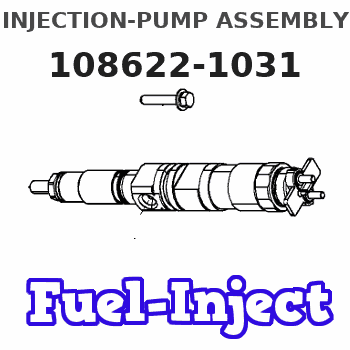
Rating:
Service parts 108622-1031 INJECTION-PUMP ASSEMBLY:
1.
_
5.
AUTOM. ADVANCE MECHANIS
7.
COUPLING PLATE
11.
Nozzle and Holder
1-15300-359-0
12.
Open Pre:MPa(Kqf/cm2)
17.7{180}/22.1{225}
14.
NOZZLE
Include in #1:
108622-1031
as INJECTION-PUMP ASSEMBLY
Cross reference number
ZEXEL
108622-1031
1086221031
ISUZU
1156031601
1156031601
Zexel num
Bosch num
Firm num
Name
Calibration Data:
Adjustment conditions
Test oil
1404 Test oil ISO4113 or {SAEJ967d}
1404 Test oil ISO4113 or {SAEJ967d}
Test oil temperature
degC
40
40
45
Nozzle and nozzle holder
105780-8250
Bosch type code
1 688 901 101
Nozzle
105780-0120
Bosch type code
1 688 901 990
Nozzle holder
105780-2190
Opening pressure
MPa
20.7
Opening pressure
kgf/cm2
211
Injection pipe
Outer diameter - inner diameter - length (mm) mm 8-3-600
Outer diameter - inner diameter - length (mm) mm 8-3-600
Overflow valve
131424-7120
Overflow valve opening pressure
kPa
255
221
289
Overflow valve opening pressure
kgf/cm2
2.6
2.25
2.95
Tester oil delivery pressure
kPa
255
255
255
Tester oil delivery pressure
kgf/cm2
2.6
2.6
2.6
PS/ACT control unit part no.
407980-2
24*
Digi switch no.
32
Direction of rotation (viewed from drive side)
Left L
Left L
Injection timing adjustment
Direction of rotation (viewed from drive side)
Left L
Left L
Injection order
1-5-3-6-
2-4
Pre-stroke
mm
8.5
8.47
8.53
Beginning of injection position
Governor side NO.1
Governor side NO.1
Difference between angles 1
Cal 1-5 deg. 60 59.75 60.25
Cal 1-5 deg. 60 59.75 60.25
Difference between angles 2
Cal 1-3 deg. 120 119.75 120.25
Cal 1-3 deg. 120 119.75 120.25
Difference between angles 3
Cal 1-6 deg. 180 179.75 180.25
Cal 1-6 deg. 180 179.75 180.25
Difference between angles 4
Cyl.1-2 deg. 240 239.75 240.25
Cyl.1-2 deg. 240 239.75 240.25
Difference between angles 5
Cal 1-4 deg. 300 299.75 300.25
Cal 1-4 deg. 300 299.75 300.25
Injection quantity adjustment
Adjusting point
-
Rack position
12.2
Pump speed
r/min
800
800
800
Average injection quantity
mm3/st.
146.5
144.5
148.5
Max. variation between cylinders
%
0
-3
3
Basic
*
Fixing the rack
*
Pre-stroke
V
2.45+-0.
01
Pre-stroke
mm
6.1+-0.0
5
Standard for adjustment of the maximum variation between cylinders
*
Injection quantity adjustment_02
Adjusting point
Z
Rack position
6.7+-0.5
Pump speed
r/min
355
355
355
Average injection quantity
mm3/st.
15
11.8
18.2
Max. variation between cylinders
%
0
-13
13
Fixing the rack
*
Pre-stroke
V
V1+0.05+
-0.01
Pre-stroke
mm
8.4+-0.0
3
Standard for adjustment of the maximum variation between cylinders
*
Remarks
Refer to items regarding the pre-stroke actuator
Refer to items regarding the pre-stroke actuator
Injection quantity adjustment_03
Adjusting point
A
Rack position
R1(12.2)
Pump speed
r/min
800
800
800
Average injection quantity
mm3/st.
146.5
144.5
148.5
Basic
*
Fixing the lever
*
Boost pressure
kPa
54.7
54.7
Boost pressure
mmHg
410
410
Pre-stroke
V
2.45+-0.
01
Pre-stroke
mm
6.1+-0.0
5
Boost compensator adjustment
Pump speed
r/min
530
530
530
Rack position
R2-2.35
Boost pressure
kPa
4
1.3
6.7
Boost pressure
mmHg
30
10
50
Boost compensator adjustment_02
Pump speed
r/min
530
530
530
Rack position
R2[R1-1.
25]
Boost pressure
kPa
41.3
41.3
41.3
Boost pressure
mmHg
310
310
310
0000001601
Pre-stroke
mm
8.5
8.47
8.53
Remarks
When the timing sleeve is pushed up
When the timing sleeve is pushed up
_02
Connector angle
deg.
8.5
8
9
Remarks
When the eccentric pin is tightened
When the eccentric pin is tightened
_03
Supply voltage
V
24
23.5
24.5
Ambient temperature
degC
23
18
28
Pre-stroke
mm
6.1
6.05
6.15
Output voltage
V
2.45
2.44
2.46
Adjustment
*
_04
Supply voltage
V
24
23.5
24.5
Ambient temperature
degC
23
18
28
Pre-stroke
mm
8.5
8.47
8.53
Output voltage
V
1.2
1
1.4
Confirmation
*
Remarks
Output voltage V1
Output voltage V1
_05
Supply voltage
V
24
23.5
24.5
Ambient temperature
degC
23
18
28
Pre-stroke
mm
5.5
Output voltage
V
3
2.98
3
Confirmation
*
_06
Supply voltage
V
24
23.5
24.5
Ambient temperature
degC
23
18
28
Output voltage
V
3.05
3.05
Confirmation of operating range
*
Test data Ex:
Governor adjustment
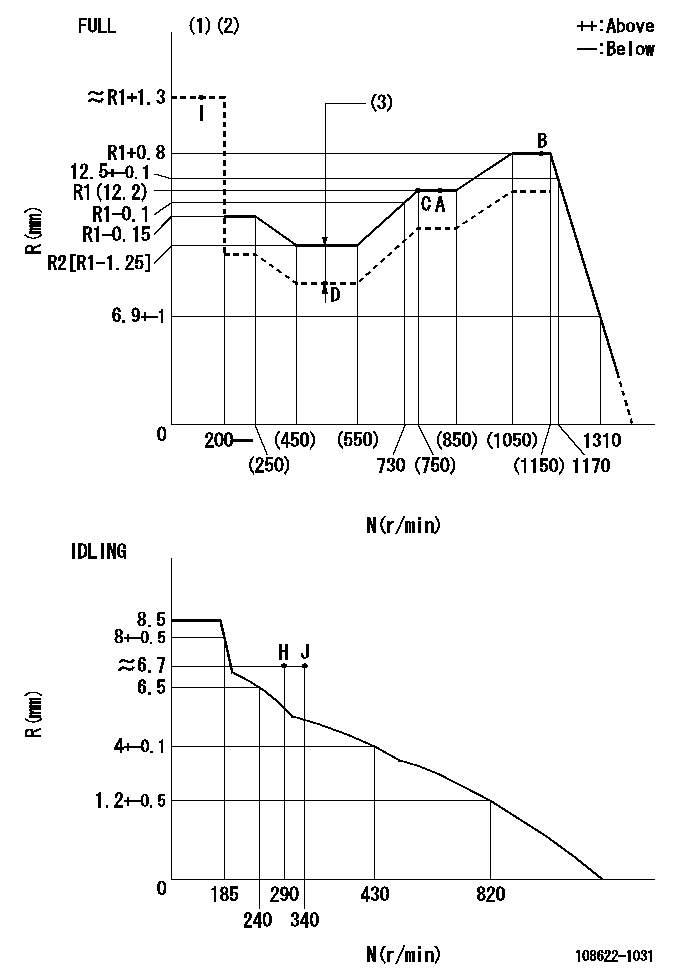
N:Pump speed
R:Rack position (mm)
(1)Torque cam stamping: T1
(2)Tolerance for racks not indicated: +-0.05mm.
(3)Boost compensator stroke: BCL
----------
T1=AE40 BCL=2.35+-0.1mm
----------
----------
T1=AE40 BCL=2.35+-0.1mm
----------
Speed control lever angle
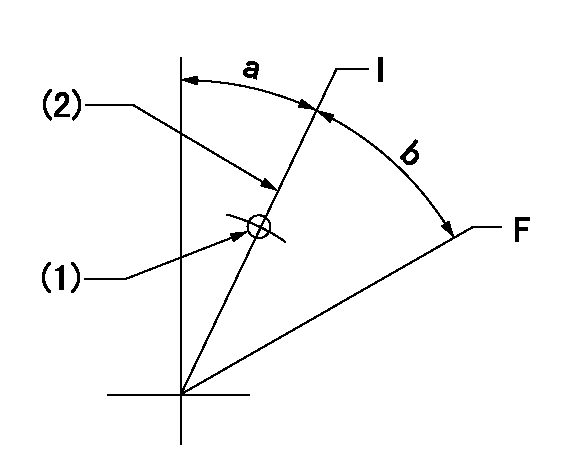
F:Full speed
I:Idle
(1)Use the pin at R = aa
(2)Stopper bolt setting
----------
aa=35mm
----------
a=27.5deg+-5deg b=28deg+-3deg
----------
aa=35mm
----------
a=27.5deg+-5deg b=28deg+-3deg
Stop lever angle
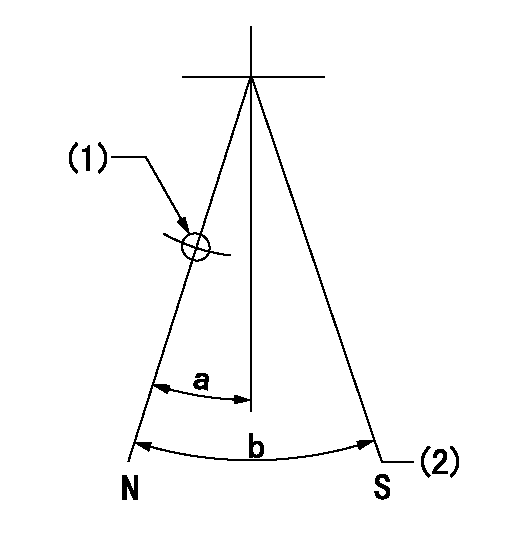
N:Pump normal
S:Stop the pump.
(1)Use the pin at R = aa
(2)Set the stopper bolt so that speed = bb and rack position = cc. (Confirm non-injection.)
----------
aa=40mm bb=0r/min cc=1.5+-0.3mm
----------
a=22deg+-5deg b=41deg+-5deg
----------
aa=40mm bb=0r/min cc=1.5+-0.3mm
----------
a=22deg+-5deg b=41deg+-5deg
0000001301
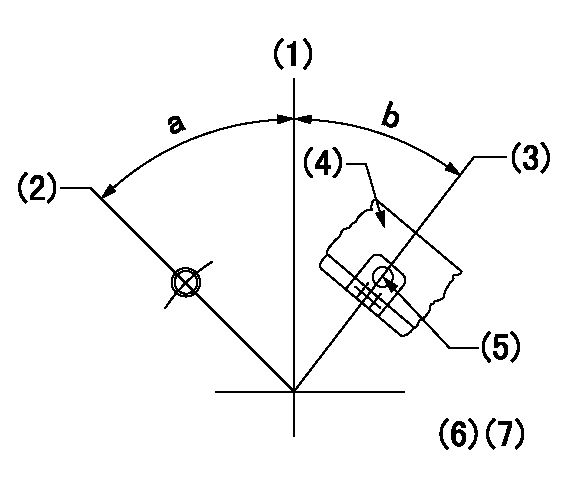
(1)Pump vertical direction
(2)Position of damper's threaded hole at No 1 cylinder's beginning of injection
(3)At the No 1 cylinder's beginning of injection position, stamp an aligning mark on the damper to align with the pointer's groove.
(4)Damper
(5)Pointer
(6)B.T.D.C.: aa
(7)Pre-stroke: bb
----------
aa=5deg bb=8.5+-0.03mm
----------
a=50deg42min+-3deg b=(44deg)
----------
aa=5deg bb=8.5+-0.03mm
----------
a=50deg42min+-3deg b=(44deg)
0000001901
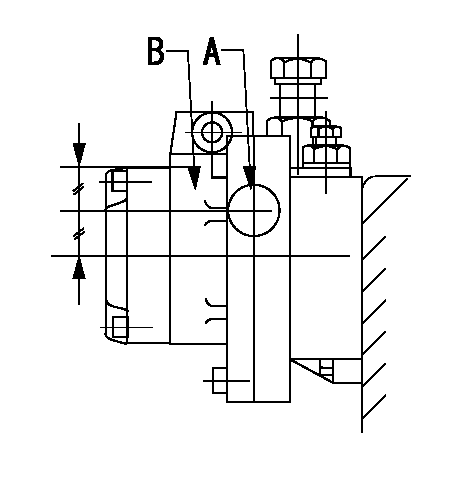
A:Sealing position
B:Pre-stroke actuator
1. When installing the pre-stroke actuator on the pump, first tighten the installation bolts loosely, then move the actuator fully counterclockwise (viewed from the drive side).
Temporary tightening torque: 1 - 1.5 N.m (0.1 - 0.15 kgf.m)
2. Move the actuator in the clockwise direction when viewed from the drive side, and adjust so that it becomes the adjustment point of the adjustment value. Then tighten it.
Tightening torque: 7^9 N.m (0.7^0.9 kgf.m)
3. After prestroke actuator installation adjustment, simultaneously stamp both the actuator side and housing side.
----------
----------
----------
----------
0000002201 RACK SENSOR
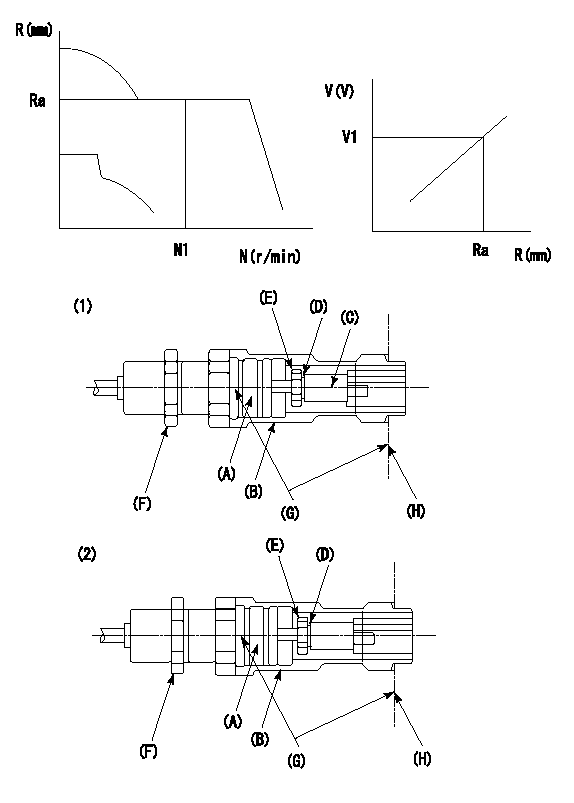
G:Red paint
H:Pump end face
P/N: part number of suitable shim
(1)Threaded type rack block
(2)Welded type rack block
Rack sensor adjustment
1. Threaded type rack sensor (-5*20, P type, no TICS rack limit).
(1)Screw in the bobbin (A) until it contacts the joint (B).
(2)Fix the pump lever.
(3)At speed N1 and rack position Ra, adjust the amount that the bobbin is screwed in so that the amp's output voltage is V1.
(4)Fix using the nut (F).
(5)Affix the caution plate to the upper part of the joint (B).
(6)Apply (G) at two places.
Connecting part between the joint (B) and the nut (F)
Connecting part between the end surface of the pump (H) and the joint (B)
2. Range for screw-in adjustment between the bobbin (A) and the joint (B) is 9 threads.
Screw in to the end from (the position where the bobbin (A) is rotated 9 turns).
Speed N1, rack position Ra, output voltage V1, rack sensor supply voltage 5+-0.01 (V)
----------
Ra=R1(12.2)+0.8mm N1=1100r/min V1=3+-0.01V
----------
----------
Ra=R1(12.2)+0.8mm N1=1100r/min V1=3+-0.01V
----------
Information:
Location of Components
Illustration 1 g06494607
Typical example
(A) DEF tank breather
(B) Heater relay
(C) DEF fast fill tank-mounted valve
(D) Plug heater
(E) Heated supply line
(F) DEF fast fill receiver
(G) DEF tank
Illustration 2 g06494608
(C) DEF fast fill tank-mounted valveThe ground level DEF fill system works much like the ground level fast fuel system. DEF fast fill tank-mounted valve (C) is mounted in DEF tank (G). Fast fill tank-mounted valve (C) has a piston that is normally closed with a spring.
Illustration 3 g06516649
(H) O-Ring seal
(J) Flow In
(K) Flow Out
(L) Back cavityNote: O-Ring seal (H) allows small amount of fluid flow.Note: The main flow through the valve is not shown.Note: During normal flow conditions there is no pressure built up in back cavity (L). Back cavity (L) is essentially "open to atmosphere".When filling, the DEF flow opens the piston, past the diverter shield and a portion flows through an orifice in the piston into the float area.
Illustration 4 g06516652
(L) Back cavity
(M) Rolling diaphragm
(N) O-Ring seal
(P) Drain holeNote: O-Ring seal (N) prevents any flow from back cavity (L).Note: Once the float rises, the pressure in back cavity (L) equals the pressure pushing the front of rolling diaphragm (M). Since the area behind rolling diaphragm (M) is greater than the area in front, along with the spring force, diaphragm (M) is held shut.When the tank level causes the float to rise high enough, the orifice is blocked, causing increased pressure on the piston until valve (C) closes. The increased pressure in the fill line then causes the nozzle attached to the receiver to shut off.The nozzle shuts off when the nozzle sees 172 to 200 kPa (25 to 29 psi) resistance. If pressure is not great enough from the source pump/supply at nozzle, there is not enough pressure built up in line between valve and nozzle to trigger nozzle shut off and DEF exits the breather-overfill.Targeted flow for the DEF supply pump should be 45 L/min (12 US gpm). Excessive flow can lead to premature shut-off of DEF nozzle.DEF tank valve (C), supply line (E), and DEF fast fill receiver (F) are electrically heated based on ambient temperature, battery, and alternator loads controlled through heater relay (B). For heated DEF hose repair kit, refer to Service Magazine, M0103829, "Repair Kits for Quick Connect Diesel Exhaust Fluid (DEF) Line Fittings Are Now Available for Certain Cat® Machine Engines".Note: If receiver (F) and supply line (E) on machine are drained for storage, the system must be refilled via the ground fill connection. The system is refilled to ensure that plug heater (D) in receiver (F) remains submerged in DEF fluid during the heating operation.
Plug heater (D) probe must be submerged at least 80% in DEF fluid to prevent overheating that could lead to plug heater (D) failing.
Illustration 1 g06494607
Typical example
(A) DEF tank breather
(B) Heater relay
(C) DEF fast fill tank-mounted valve
(D) Plug heater
(E) Heated supply line
(F) DEF fast fill receiver
(G) DEF tank
Illustration 2 g06494608
(C) DEF fast fill tank-mounted valveThe ground level DEF fill system works much like the ground level fast fuel system. DEF fast fill tank-mounted valve (C) is mounted in DEF tank (G). Fast fill tank-mounted valve (C) has a piston that is normally closed with a spring.
Illustration 3 g06516649
(H) O-Ring seal
(J) Flow In
(K) Flow Out
(L) Back cavityNote: O-Ring seal (H) allows small amount of fluid flow.Note: The main flow through the valve is not shown.Note: During normal flow conditions there is no pressure built up in back cavity (L). Back cavity (L) is essentially "open to atmosphere".When filling, the DEF flow opens the piston, past the diverter shield and a portion flows through an orifice in the piston into the float area.
Illustration 4 g06516652
(L) Back cavity
(M) Rolling diaphragm
(N) O-Ring seal
(P) Drain holeNote: O-Ring seal (N) prevents any flow from back cavity (L).Note: Once the float rises, the pressure in back cavity (L) equals the pressure pushing the front of rolling diaphragm (M). Since the area behind rolling diaphragm (M) is greater than the area in front, along with the spring force, diaphragm (M) is held shut.When the tank level causes the float to rise high enough, the orifice is blocked, causing increased pressure on the piston until valve (C) closes. The increased pressure in the fill line then causes the nozzle attached to the receiver to shut off.The nozzle shuts off when the nozzle sees 172 to 200 kPa (25 to 29 psi) resistance. If pressure is not great enough from the source pump/supply at nozzle, there is not enough pressure built up in line between valve and nozzle to trigger nozzle shut off and DEF exits the breather-overfill.Targeted flow for the DEF supply pump should be 45 L/min (12 US gpm). Excessive flow can lead to premature shut-off of DEF nozzle.DEF tank valve (C), supply line (E), and DEF fast fill receiver (F) are electrically heated based on ambient temperature, battery, and alternator loads controlled through heater relay (B). For heated DEF hose repair kit, refer to Service Magazine, M0103829, "Repair Kits for Quick Connect Diesel Exhaust Fluid (DEF) Line Fittings Are Now Available for Certain Cat® Machine Engines".Note: If receiver (F) and supply line (E) on machine are drained for storage, the system must be refilled via the ground fill connection. The system is refilled to ensure that plug heater (D) in receiver (F) remains submerged in DEF fluid during the heating operation.
Plug heater (D) probe must be submerged at least 80% in DEF fluid to prevent overheating that could lead to plug heater (D) failing.